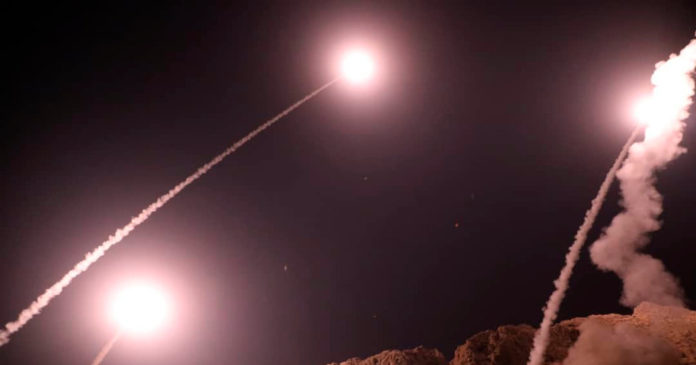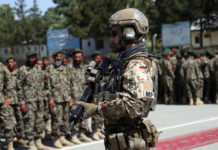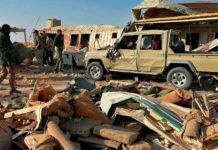BEIRUT — Iran fired six medium-range ballistic missiles across Iraq and into Syria early Monday at what it said was an Islamic State base, according to Iranian news agencies, its allies and spokesmen for Iran’s Revolutionary Guards Corps.
The Revolutionary Guards described the strike as retaliation for an attack in Ahvaz, Iran, on Sept. 22 against a military parade by its soldiers in which at least 25 people were killed, including 12 members of the elite unit plus civilian spectators and at least one young child.
Iran initially attributed the attack to an Arab separatist group backed by the United States, Israel, the United Arab Emirates and Saudi Arabia. But the missile strike was on what it said was the headquarters of the Islamic State group in the eastern Euphrates River valley, close to Syria’s border with Iraq. The area is one of the last strongholds of the Islamic State, also called ISIS and Daesh, after its Arabic acronym, and has also been the site of recent American military activity.
It was not immediately clear whether Iran was now blaming the Islamic State exclusively for the attack, a combination of ISIS and the Arab separatist group or, implausibly, those groups and the foreign powers it named previously.
A spokesman for the United States military in Syria and Iraq, Col. Sean Ryan, confirmed that a missile strike had taken place. “At this time, the coalition is still assessing if any damage occurred, and no coalition forces were in danger,” he said. “The Iranian forces did not do any prior notice last night, and we are still assessing if there is any damage.”
The missile launch, at least the second time Iran has fired ballistic missiles into Syria, was bound to be seen by the United States as a provocative action, especially with the Trump administration’s pulling out of a nuclear deal with Iran, in part because it does not place severe enough limits on Iran’s ballistic missile capabilities.
European countries have refused to break off the deal, and Iran has said it will still abide by it. Part of the agreement, under which Iran disavows a nuclear weapons program, puts some limits on new ballistic missile technology.
The Revolutionary Guards released video of a missile being launched and said in a statement that “many takfiris and Daesh leaders who were behind the Ahvaz attack were killed and wounded by the missiles,” according to a report by the Lebanese news agency Al Manar, which is run by Hezbollah, an Iranian ally. Takfiri is an epithet that refers to the extremist, anti-Shiite views of the Islamic State and other hard-line Sunni groups.
Iranian news agencies said the missiles had been fired from Kermanshah Province, which at its nearest point to Syria is at least 280 miles. Neither missile has sufficient range if fired from Iran to reach Israel.
Shortly after the missile strikes, the Republican Guards also launched seven drones that the semiofficial Fars news agency said targeted “the terrorists’ positions in the region.” Iran has boasted of having drones capable of carrying bombs, but it is not known whether it has deployed them in combat.
Hashim Almosawa, the spokesman for the pro-Iranian Alnujaba Brigade in Iraq, praised the Iranian missile strike, which had to cross more than 200 miles of Iraqi territory.
“Iran could have launched the rockets from Syria, but they have sent a strong and accurate message to the terrorists and those who support them that our rockets could hit any one of you,” he said, noting that the strike area was in the American zone of operations in Syria.
“Iran has the right to retaliate and defend itself,” he added, “and I do not think that there is any international violation in this.”
According to the Fars news agency, “At least one of the missiles bore the slogans ‘Death to America,’ ‘Death to Israel,’ ‘Death to Al Saud’ and a Koranic verse meaning ‘fight against the friends of Satan.’” Al Saud is how Iran refers to Saudi Arabia.
The Syrian Observatory for Human Rights, which is based in London and has a network of activists in Syria, confirmed that some missiles struck in the eastern part of Deir al-Zour Province in Syria, near Bukamal. It said that loud explosions had been heard near Hajin, a town under Islamic State control, but there were no immediate reports on casualties.
The Observatory noted that there had been recent fighting in that area between the Islamic State and the United States and its allies, the Syrian Democratic Forces.
The Sept. 22 attack in Ahvraz, Iran, was carried out by four or five militants who ambushed a ceremonial parade by the Revolutionary Guards in the city, which is in an area of southwestern Iran with a large ethnic Arab minority.
While the parading Guards were carrying weapons, they were apparently not loaded, a normal practice in military parades. Video emerged of Iranian soldiers running and hiding from the attackers but not fighting back, causing widespread anger in Iran and among its allies, who complained that the United States and its allies treated the attack as militarily justifiable.
A Hezbollah field commander in the area of Syria where the strikes occurred, reached over social media and speaking on the condition of anonymity in line with the group’s policy, said that Iranian drones had fired rockets at the Islamic State military headquarters, shortly after the missiles struck.
The Hezbollah commander said his organization and the Iranians had coordinated the attack with the Syrian government and its Russian backers, but he made no mention of the American forces in the area.
Follow Hwaida Saad and Rod Nordland on Twitter: @hwaida_saad and @rodnordland
Hwaida Saad reported from Beirut and Rod Nordland from Rome. Falih Hassan contributed reporting from Baghdad.
Source : Nytimes













